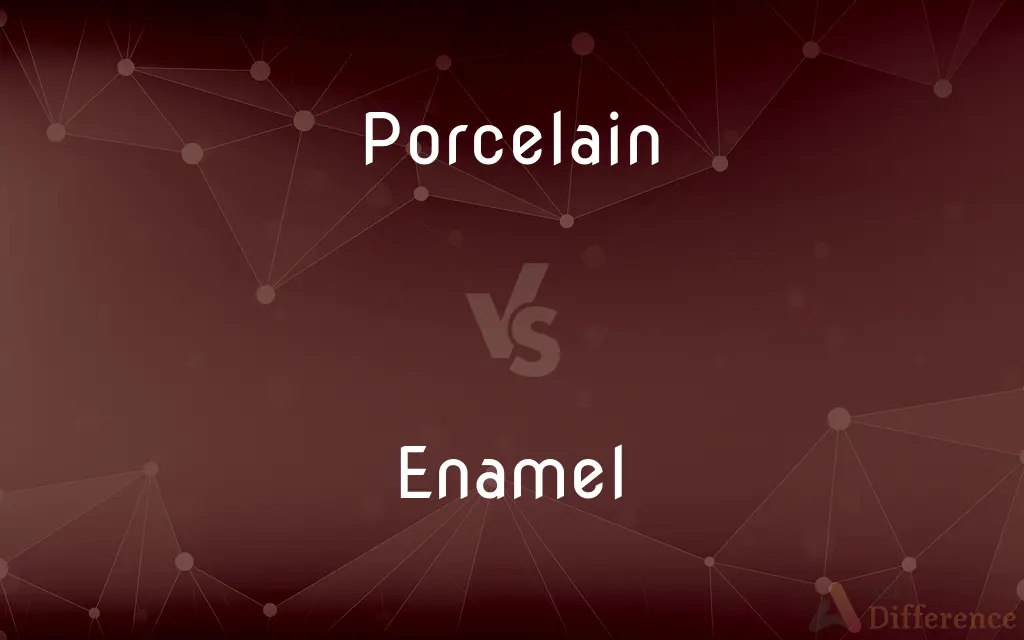Porcelain vs. Enamel — What's the Difference?
Edited by Tayyaba Rehman — By Fiza Rafique — Updated on October 30, 2023
Porcelain is a white, translucent ceramic made by heating clay, while enamel is a protective or decorative coating made by melting glass powder onto a surface.

Difference Between Porcelain and Enamel
Table of Contents
ADVERTISEMENT
Key Differences
Porcelain and enamel, both admired for their aesthetic appeal, differ fundamentally in composition and application.
Porcelain is a type of ceramic crafted from clay, usually kaolin, fired at high temperatures. In contrast, enamel is a melted glass powder fused to metals, ceramics, or even other glass surfaces.
The versatility and durability of porcelain make it popular for various products.
Porcelain is commonly used for fine china, tiles, and even dental crowns due to its strength and beauty. Enamel, on the other hand, acts as a protective or decorative layer, often found on cookware, jewelry, and dental structures.
In the creation process, porcelain undergoes a transformation.
ADVERTISEMENT
When fired at high temperatures, porcelain achieves its characteristic translucence and strength. Conversely, enamel requires a substrate, like metal, upon which the powdered glass melts, creating a smooth, durable coating.
One can often distinguish between porcelain and enamel based on appearance and feel.
Porcelain typically exhibits a smooth, shiny, and often translucent quality. Enamel, however, presents a glossy surface, with its color coming from added pigments to the glass powder.
Though both materials are celebrated for their beauty, they serve different primary functions.
Porcelain stands as a material on its own, crafted into various objects. In contrast, enamel enhances or protects another material by adding a layer to its surface.
Comparison Chart
Composition
Ceramic made from clay, primarily kaolin
Melted glass powder
Application
Used as a standalone material for objects
Used as a coating on metals, ceramics, or glass
Manufacturing Process
Fired at high temperatures to achieve translucence
Powdered glass melted onto a substrate
Common Uses
Fine china, tiles, dental crowns
Cookware, jewelry, dental structures
Appearance
Translucent, smooth, shiny
Glossy, colored surface from added pigments
Compare with Definitions
Porcelain
Translucent ceramic made by firing pure clay.
The museum displayed ancient porcelain dishes from various dynasties.
Enamel
A glossy, decorative or protective coating.
The enamel finish on the vintage car kept it looking pristine.
Porcelain
A substance often used in dental prosthetics.
The dentist used porcelain for the crown to match the patient's other teeth.
Enamel
A hard, colored surface on metals or ceramics.
The cookware had a red enamel coating that was both durable and attractive.
Porcelain
A fine, white ceramic material.
The porcelain vase from China was delicate and beautifully painted.
Enamel
The outermost layer of a tooth.
Regular brushing helps protect the enamel of your teeth.
Porcelain
Porcelain () is a ceramic material made by heating materials, generally including a material like kaolin, in a kiln to temperatures between 1,200 and 1,400 °C (2,200 and 2,600 °F). The strength, and translucence of porcelain, relative to other types of pottery, arises mainly from vitrification and the formation of the mineral mullite within the body at these high temperatures.
Enamel
A vitreous, usually opaque, protective or decorative coating baked on metal, glass, or ceramic ware.
Porcelain
A hard, white, translucent ceramic made by firing a pure clay and then glazing it with variously colored fusible materials; china.
Enamel
An object having such a coating, as in a piece of cloisonné.
Porcelain
An object made of this substance.
Enamel
A coating that dries to a hard glossy finish
Nail enamel.
Porcelain
A hard white translucent ceramic, originally made by firing kaolin, quartz, and feldspar at high temperatures but now also inclusive of similar artificial materials; also often (figurative) such a material as a symbol of the fragility, elegance, etc. traditionally associated with porcelain goods.
Tableware and toilets are both made of porcelain.
Enamel
A paint that dries to a hard glossy finish.
Porcelain
Syn of china: porcelain tableware.
He set the table with our porcelain and stemware.
Enamel
(Anatomy) The hard, calcareous substance covering the exposed portion of a tooth.
Porcelain
Syn of kaolin: the kind of clay traditionally used in China to manufacture porcelain.
Enamel
To coat, inlay, or decorate with enamel.
Porcelain
An object made of porcelain, (particularly) art objects or items of tableware.
The museum has an extensive collection of rare Chinese porcelains.
Enamel
To give a glossy or brilliant surface to.
Porcelain
Syn of cowrie.
Enamel
To adorn with a brightly colored surface.
Porcelain
Syn of wampum: strings of shells, beads, etc. used as ornamentation or currency; the composite shells, beads, etc.
Enamel
An opaque, glassy coating baked onto metal or ceramic objects.
Porcelain
A kind of pigeon with deep brown and off-white feathers.
Enamel
A coating that dries to a hard, glossy finish.
Porcelain
Purslain.
Enamel
The hard covering on the exposed part of a tooth.
Porcelain
A fine translucent or semitransculent kind of earthenware, made first in China and Japan, but now also in Europe and America; - called also China, or China ware.
Porcelain, by being pure, is apt to break.
Enamel
A cosmetic intended to give the appearance of a smooth and beautiful complexion.
Porcelain
Ceramic ware made of a more or less translucent ceramic
Enamel
(transitive) To coat or decorate with enamel.
Porcelain
A material used for crafting fine china and pottery.
Her dining set was made of high-quality porcelain and adorned with intricate designs.
Enamel
(transitive) To variegate with colours, as if with enamel.
Porcelain
A ceramic known for its strength and translucence.
The porcelain tile in the bathroom added an elegant touch.
Enamel
(transitive) To form a glossy surface like enamel upon.
To enamel card paper; to enamel leather or cloth
Enamel
(transitive) To disguise with cosmetics, as a woman's complexion.
Enamel
A variety of glass, used in ornament, to cover a surface, as of metal or pottery, and admitting of after decoration in color, or used itself for inlaying or application in varied colors.
Enamel
A glassy, opaque bead obtained by the blowpipe.
Enamel
That which is enameled; also, any smooth, glossy surface, resembling enamel, especially if variegated.
Enamel
The intensely hard calcified tissue entering into the composition of teeth. It merely covers the exposed parts of the teeth of man, but in many animals is intermixed in various ways with the dentine and cement.
Enamel
Any one of various preparations for giving a smooth, glossy surface like that of enamel.
Enamel
A cosmetic intended to give the appearance of a smooth and beautiful complexion.
Enamel
To lay enamel upon; to decorate with enamel whether inlaid or painted.
Enamel
To variegate with colors as if with enamel.
Oft he [the serpent]bowedHis turret crest and sleek enameled neck.
Enamel
To form a glossy surface like enamel upon; as, to enamel card paper; to enamel leather or cloth.
Enamel
To disguise with cosmetics, as a woman's complexion.
Enamel
To practice the art of enameling.
Enamel
Relating to the art of enameling; as, enamel painting.
Enamel
Hard white substance covering the crown of a tooth
Enamel
A colored glassy compound (opaque or partially opaque) that is fused to the surface of metal or glass or pottery for decoration or protection
Enamel
A paint that dries to a hard glossy finish
Enamel
Any smooth glossy coating that resembles ceramic glaze
Enamel
Coat, inlay, or surface with enamel
Enamel
Melted glass powder fused onto a surface.
The enamel artwork on the pendant made it truly unique.
Enamel
A paint that dries to a hard, glossy finish.
He used white enamel paint for the wooden fence.
Common Curiosities
How is porcelain's translucence achieved?
Porcelain becomes translucent when fired at high temperatures.
What's the significance of kaolin in porcelain?
Kaolin is a type of clay that, when fired, gives porcelain its fine quality and translucence.
How does enamel protect surfaces?
Enamel provides a hard, glossy layer that can be both decorative and protective against wear or corrosion.
What are some common uses of porcelain?
Porcelain is often used for fine china, tiles, and dental crowns.
What gives enamel its color?
Enamel gets its color from pigments added to the glass powder.
Is porcelain only white?
While porcelain is often white, it can be tinted or painted various colors.
Do all ceramics qualify as porcelain?
No, porcelain is a specific type of ceramic known for its whiteness and translucence.
What is the primary material in porcelain?
Porcelain is primarily made from clay, especially kaolin.
Are porcelain and enamel used interchangeably?
No, while both have decorative purposes, porcelain is a ceramic material and enamel is a coating.
Can enamel be used on porcelain?
Yes, enamel can be fused onto porcelain as a decorative or protective layer.
Is enamel considered a type of ceramic?
No, enamel is a melted glass powder used as a coating.
Can enamel chip or crack?
Yes, while enamel is durable, it can chip or crack if subjected to hard impacts.
How do I care for enamel-coated items?
Avoid abrasive cleaners and hard impacts to maintain the enamel's shine and prevent chipping.
Are porcelain and enamel resistant to heat?
Both porcelain and enamel can withstand high temperatures, making them suitable for various applications.
How is enamel applied to a surface?
Enamel, in powdered glass form, is applied to a surface and then heated until it melts and fuses.
Share Your Discovery

Previous Comparison
Angst vs. Fear
Next Comparison
Molt vs. MoultAuthor Spotlight
Written by
Fiza RafiqueFiza Rafique is a skilled content writer at AskDifference.com, where she meticulously refines and enhances written pieces. Drawing from her vast editorial expertise, Fiza ensures clarity, accuracy, and precision in every article. Passionate about language, she continually seeks to elevate the quality of content for readers worldwide.
Edited by
Tayyaba RehmanTayyaba Rehman is a distinguished writer, currently serving as a primary contributor to askdifference.com. As a researcher in semantics and etymology, Tayyaba's passion for the complexity of languages and their distinctions has found a perfect home on the platform. Tayyaba delves into the intricacies of language, distinguishing between commonly confused words and phrases, thereby providing clarity for readers worldwide.














































